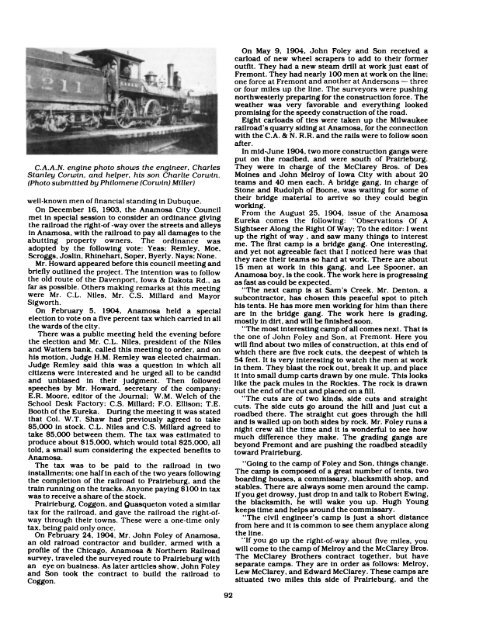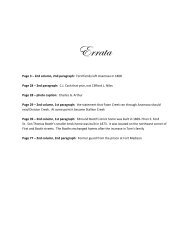Anamosa - A Reminiscence 1838 - 1988
The definitive history of the community of Anamosa, Iowa, USA
The definitive history of the community of Anamosa, Iowa, USA
Create successful ePaper yourself
Turn your PDF publications into a flip-book with our unique Google optimized e-Paper software.
IT- E-T‘ t-<br />
C.A.A.N. engine photo shows the engineer, Charles<br />
Stanley Corwin, and helper. his son Charlie Corwin.<br />
(Photo submitted by Philomene (Corwin) Miller)<br />
well-known men of financial standing in Dubuque.<br />
On December 16, 1903, the <strong>Anamosa</strong> City Council<br />
met in special session to consider an ordinance giving<br />
the railroad the right-of -way over the streets and alleys<br />
in <strong>Anamosa</strong>. with the railroad to pay all damages to the<br />
abutting property owners. The ordinance was<br />
adopted by the following vote: Yeas; Remley, Moe.<br />
Scroggs. Joslin, Rhinehart. Soper, Byerly. Nays: None.<br />
Mr. Howard appeared before this council meeting and<br />
briefly outlined the project. The intention was to follow<br />
the old route of the Davenport, Iowa 81 Dakota Rd., as<br />
far as possible. Others making remarks at this meeting<br />
were Mr. C.L. Niles, Mr. C.S. Millard and Mayor<br />
Sigworth.<br />
On February 5. 1904, <strong>Anamosa</strong> held a special<br />
election to vote on a flve percent tax which carried in all<br />
the wards of the city.<br />
There was a public meeting held the evening before<br />
the election and Mr. C.L. Niles. president of the Niles<br />
and Watters bank, called this meeting to order, and on<br />
his motion, Judge H.M. Remley was elected chairman.<br />
Judge Remley said this was a question in which all<br />
citizens were interested and he urged all to be candid<br />
and unbiased in their judgment. Then followed<br />
speeches by Mr. Howard, secretary of the company:<br />
E.R. Moore, editor of the Journal; W.M. Welch of the<br />
School Desk Factory: C.S. Millard: F.O. Ellison: T.E.<br />
Booth of the Eureka. During the meeting it was stated<br />
that Col. W.T. Shaw had previously agreed to take<br />
$5,000 in stock. C.L. Niles and C.S. Millard agreed to<br />
take $5,000 between them. The tax was estimated to<br />
produce about $15,000, which would total $25,000, all<br />
told, a small sum considering the expected benefits to<br />
<strong>Anamosa</strong>.<br />
The tax was to be paid to the railroad in two<br />
installments; one half in each of the two years following<br />
the completion of the railroad to Prairieburg. and the<br />
train running on the tracks. Anyone paying $100 in tax<br />
was to receive a share of the stock.<br />
Prairieburg, Coggon, and Quasqueton voted a similar<br />
tax for the railroad. and gave the railroad the right-ofway<br />
through their towns. These were a one-time only<br />
tax, being paid only once.<br />
On February 24, 1904, Mr. John Foley of <strong>Anamosa</strong>,<br />
an old rairoad contractor and builder, armed with a<br />
proflle of the Chicago, <strong>Anamosa</strong> 8: Northern Railroad<br />
survey. traveled the surveyed route to Prairieburg with<br />
an eye on business. As later articles show, John Foley<br />
and Son took the contract to build the railroad to<br />
Coggon.<br />
On May 9. I904. John Foley and Son received a<br />
carload of new wheel scrapers to add to their former<br />
outflt. They had a new steam drill at work just east of<br />
Fremont. They had nearly 100 men at work on the line:<br />
one force at Fremont and another at Andersons —— three<br />
or four miles up the line. The surveyors were pushing<br />
northwesterly preparing for the construction force. The<br />
weather was very favorable and everything looked<br />
promising for the speedy construction of the road.<br />
Eight carloads of ties were taken up the Milwaukee<br />
rallroad's quarry siding at <strong>Anamosa</strong>, for the connection<br />
with the C.A. 8: N. R.R. and the rails were to follow soon<br />
after.<br />
In mid-June 1904, two more construction gangs were<br />
put on the roadbed, and were south of Prairieburg.<br />
They were in charge of the McClarey Bros. of Des<br />
Moines and John Melroy of Iowa City with about 20<br />
teams and 40 men each. A bridge gang. in charge of<br />
Stone and Rudolph of Boone, was waiting for some of<br />
their bridge material to arrive so they could begin<br />
working.<br />
From the August 25. 1904, issue of the <strong>Anamosa</strong><br />
Eureka comes the following: "Observations Of A<br />
Sightseer Along the Right Of Way: To the editor: I went<br />
up the right of way , and saw many things to interest<br />
me. The first camp is a bridge gang. One interesting,<br />
and yet not agreeable fact that I noticed here was that<br />
they race their teams so hard at work. There are about<br />
15 men at work in this gang, and Lee Spooner, an<br />
<strong>Anamosa</strong> boy, is the cook. The work here is progressing<br />
as fast as could be expected.<br />
“The next camp is at Sam's Creek. Mr. Denton. a<br />
subcontractor, has chosen this peaceful spot to pitch<br />
his tents. He has more men working for him than there<br />
are in the bridge gang. The work here is grading.<br />
mostly in dirt, and will be finished soon.<br />
“The most interesting camp ofall comes next. That is<br />
the one of John Foley and Son, at Fremont. Here you<br />
will find about two miles of construction. at this end of<br />
which there are five rock cuts, the deepest of which is<br />
54 feet. It is very interesting to watch the men at work<br />
in them. They blast the rock out. break it up. and place<br />
it into small dump carts drawn by one mule. This looks<br />
like the pack mules in the Rockies. The rock is drawn<br />
out the end of the cut and placed on a fill.<br />
“The cuts are of two kinds. side cuts and straight<br />
cuts. The side cuts go around the hill and just cut a<br />
roadbed there. The straight cut goes through the hill<br />
and is walled up on both sides by rock. Mr. Foley runs a<br />
night crew all the time and it is wonderful to see how<br />
much difference they make. The grading gangs are<br />
beyond Fremont and are pushing the roadbed steadily<br />
toward Prairieburg.<br />
"Going to the camp of Foley and Son, things change.<br />
The camp is composed of a great number of tents, two<br />
boarding houses, a commissary. blacksmith shop. and<br />
stables. There are always some men around the camp.<br />
If you get drowsy, just drop in and talk to Robert Ewing.<br />
the blacksmith, he will wake you up. Hugh Young<br />
keeps time and helps around the commissary.<br />
"The civil engineer's camp is just a short distance<br />
from here and it is common to see them anyplace along<br />
the line.<br />
"If you go up the right-of-way about flve miles, you<br />
will come to the camp of Melroy and the McClarey Bros.<br />
The McClarey Brothers contract together. but have<br />
separate camps. They are in order as follows: Melroy,<br />
Lew McClarey, and Edward McClarey. These camps are<br />
situated two miles this side of Prairieburg. and the



